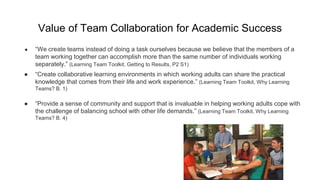
Introduction to Collaboration in Learning
Collaboration in learning has become a buzzword in educational circles, and for good reason. The age-old saying “two (or more) heads are better than one” rings true now more than ever. When students come together to share ideas, knowledge, and skills, the possibilities expand beyond individual capabilities. Gone are the days of solitary study sessions where information retention was often a struggle.
Imagine a classroom filled with vibrant discussions, diverse perspectives, and collective problem-solving. This dynamic environment not only enhances understanding but also fosters essential life skills like communication and teamwork. As we dive deeper into the role of collaboration in learning, you’ll discover how working together can transform education into an engaging adventure rather than just another academic obligation. Let’s explore why embracing collaboration is crucial for achieving academic success!
The Benefits of Collaborative Learning
Collaborative learning opens doors to a wealth of benefits that enhance the educational experience. When learners come together, they share diverse perspectives, enriching discussions and sparking creativity.
Working in groups encourages critical thinking as individuals challenge one another’s ideas. This exchange cultivates deeper understanding and retention of information.
Another significant advantage is the development of essential social skills. Participants learn to communicate effectively, negotiate solutions, and build relationships with peers. These skills are invaluable both inside and outside academic settings.
Moreover, collaboration fosters a sense of community among learners. Students feel more connected when they work towards common goals, which can boost motivation and engagement in the learning process.
Collaborative environments often lead to improved problem-solving abilities. Tackling challenges collectively allows for innovative solutions that might not emerge through solitary study approaches.
The Impact of Technology on Collaborative Learning
Technology has revolutionized the landscape of collaborative learning. Online platforms enable students to connect across distances, fostering teamwork regardless of geographical barriers.
Virtual classrooms and discussion forums allow for real-time interaction. Students can share ideas instantly, whether they are in the same room or continents apart. This immediacy enhances engagement and encourages diverse perspectives.
Tools like Google Docs and Trello facilitate project management, making it easy for groups to collaborate effectively. They streamline communication and keep everyone on track with shared tasks.
Moreover, video conferencing tools provide a personal touch that text-based communication often lacks. Face-to-face interactions through screens build rapport among team members while enabling more profound discussions.
Incorporating technology into collaborative learning not only enriches the educational experience but also prepares students for a modern workforce that thrives on cooperation and innovation.
Strategies for Effective Collaboration in Learning
Effective collaboration in learning thrives on clear communication. Establishing open channels allows participants to express ideas freely. Encourage active listening; it fosters understanding and respect among peers.
Setting specific goals can enhance focus. When everyone knows the objective, they work together seamlessly toward achievement. Using project management tools helps keep tasks organized and deadlines visible.
Encouraging diversity within groups enriches discussions. Different perspectives lead to innovative solutions that might not emerge in isolation. Create an inclusive environment where every voice is valued.
Regular check-ins are vital for gauging progress and addressing concerns early on. This practice builds accountability and keeps motivation high.
Embrace flexibility during the collaborative process. Adaptability allows teams to navigate challenges without losing momentum or enthusiasm for shared learning experiences.

Overcoming Challenges in Collaborative Learning
Collaborative learning offers immense benefits, but it’s not without its hurdles. One common challenge is differing communication styles among participants. Some may prefer direct feedback while others favor a more diplomatic approach.
Building trust is another vital element that can be difficult to establish. When team members don’t feel comfortable sharing their ideas, the group dynamic falters.
Time management often proves tricky as well. Coordinating schedules and ensuring everyone contributes equally can lead to frustration if not addressed early on.
Additionally, conflict resolution skills are essential in navigating disagreements that arise during group discussions. Encouraging open dialogue helps mitigate misunderstandings and fosters a supportive atmosphere.
Understanding these challenges empowers teams to implement effective strategies for collaboration in learning environments, creating a more enriching experience for all involved.
Case Studies: Successful Collaborative Learning Examples
One notable example of successful collaborative learning comes from the University of Chicago. Students were grouped into diverse teams to tackle real-world problems in a project-based course. They collaborated, shared different perspectives, and ultimately developed innovative solutions that impressed local businesses.
Another compelling instance is found in high schools using peer tutoring programs. In these settings, students with varying strengths work together on subjects like math and science. The stronger students reinforce their knowledge while helping others grasp challenging concepts.
In a corporate setting, companies like Google have adopted team-based projects to enhance employee skills. Their approach fosters creativity by allowing employees to brainstorm collaboratively, leading to groundbreaking products and services.
These case studies illustrate how collaboration can drive success across various educational levels and professional environments.
Conclusion: The Power of Collaboration in Achieving Academic Success
Collaboration in learning is transformative. It enhances understanding, fosters creativity, and builds essential skills for the future. When individuals come together, they create a rich tapestry of ideas and perspectives. This diversity leads to deeper insights and innovative solutions.
The benefits are numerous: improved problem-solving abilities, increased motivation, and heightened engagement among learners. Each participant brings unique strengths that contribute to a collective outcome greater than individual efforts alone.
As technology continues to advance, it further facilitates collaboration. Online tools make it easier for people across distances to connect and work together seamlessly. This opens doors for diverse teams that can tackle challenges from various angles.
Implementing effective strategies is key to maximizing collaborative experiences in educational settings. Encouraging open communication and establishing clear goals can help ensure everyone’s voice is heard.
While there may be obstacles along the way—like differing opinions or unequal participation—the rewards of overcoming these challenges far outweigh them. The journey towards successful collaboration enriches not just academic results but also personal growth.
Real-world examples demonstrate how powerful collaboration can be in achieving success. Schools employing group projects often see significant improvements in student performance as peers learn from one another’s strengths.
Harnessing the power of multiple minds creates an environment where learning flourishes; it’s a reminder that sometimes two heads—or even more—truly are better than one when striving for knowledge and achievement.




Leave a Reply